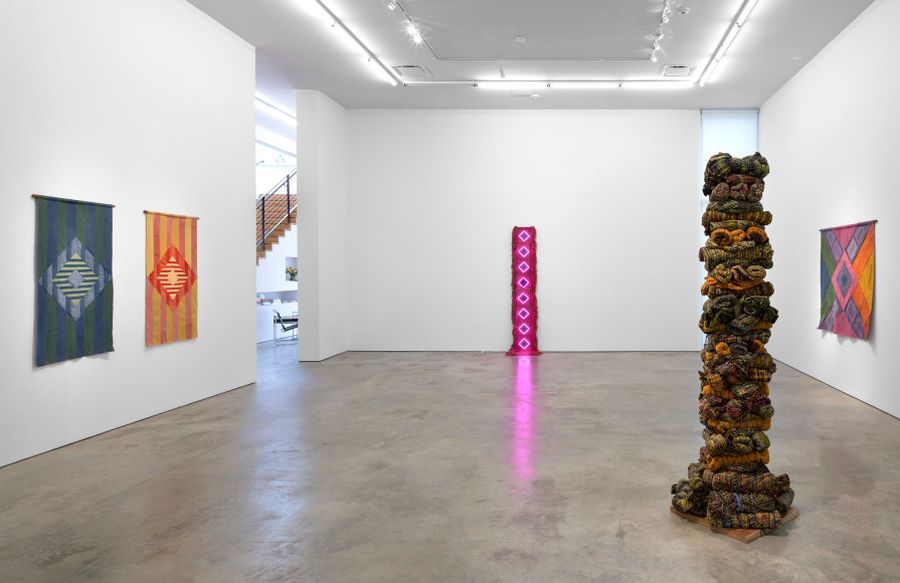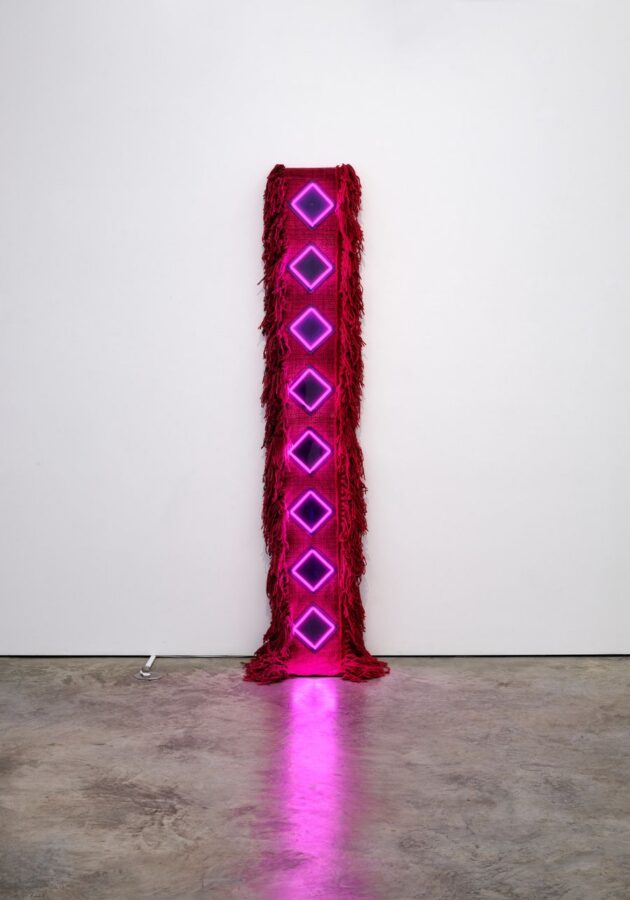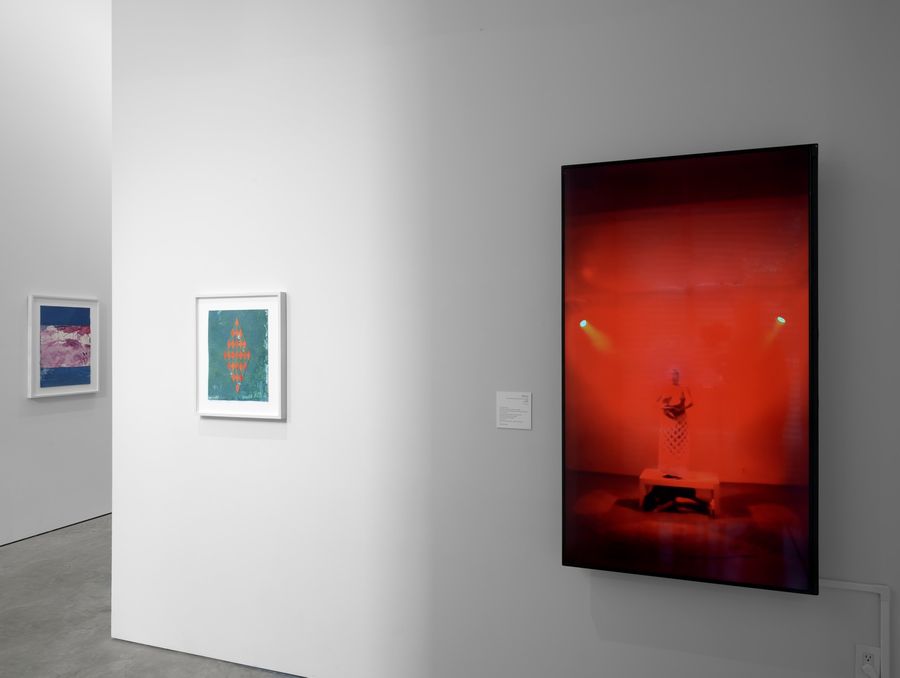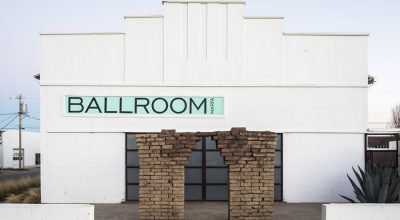
SANDRA MONTERROSO: THE HEALING PARADOX
Alma Ruiz | Independent Curator and Art Historian
The Healing Paradox marks Sandra Monterroso’s second solo show at Sicardi | Ayers | Bacino. Continuing her interest in Guatemalan textiles as art-making material and as tools to address her country’s embattled history, Monterroso, an artist with Maya Q’eqchi’ roots, focuses her attention this time on more modest materials. Leftover fabrics from a local rug factory and organic cotton and linen embellished with embroidery and neon lights effectively become a compelling locus where discussions about healing wounds within a complex postcolonial heritage occur.
Monterroso utilizes soft materials paired with manufactured objects to construct visual paradoxes. For example, several pieces are made of fabrics originally destined for landfills. Woven by indigenous hands who labor for low salaries to produce beautifully crafted rugs for luxury homes, the scraps tangentially point to a socioeconomic hierarchy between the haves and have-nots. In rescuing the discarded materials, Monterroso performs a redeeming ritual, imbuing them with new life as artworks and, paradoxically, transforming them into repositories of the inequalities, discrimination, and racism that still exist toward marginalized groups without openly highlighting their victimization. In their conclusive form, the pieces are joined to create a whole, mending leads to metaphorical healing.



Color is an important signifier connecting Maya Q’eqchi’s culture to Monterroso’s personal history. The artist is known for her extensive use of indigo and cochineal dyes, with which she colors her textiles and yarns. There is evidence that the Mayas used indigo to create Mayan blue, a pigment developed in the late pre-Classic period, 1900 BC to 200 AD. It can be found in Mesoamerican pottery, murals, and archeological artifacts. The cochineal comes from a tiny cactus-dwelling insect harvested to produce a red dye. While the indigenous people used the red pigment to dye their textiles and for its healing properties and associations with divine light and the sun, the Spanish conquistadors viewed it as a source of wealth. As European demand for cochineal increased, its production became another form of indigenous exploitation.
The inclusion of these pigments in the title of many of Monterroso’s works, for example, Like the Triangles: The Celestial Water and the Indigofera Give Us Back the Light and Like the Rhombus: The Earth and the Cochineal Give us Back the Light, underscores their relevance in the rituals of her ancestors and her role in preserving such knowledge.
The triangle and diamond-shaped neon lights appended to the fabric stand in for territory/land; the slightly discernible circle inside the neon is a seed, a symbol of birth, growth, and land cultivation. To say that their inclusion seems paradoxical is true; their electric-powered presence gives back the light needed in an altered state of consciousness to enter a moment of reflection on modernity or, more precisely, on the open wounds resulting from the encounters and disagreements that occurred while going through this modernity.



Monterroso’s exploration of healing within a postcolonial context is also expressed in Rombhus to Heal Wounds, a beautiful, bright-colored cotton piece embroidered with recetas* widely used for physical and spiritual healing. Here we can find prescriptions for curing the evil eye, ‘frights,’ cancer, and other ailments. One of them reads, Prescription for the evil eye (non-physical): In a cloth bag, put a few grains of achiote (annatto) and some cross-shaped chili peppers, pass [the bag] all over the [patient’s] body, tracing the shape of a cross, and throw it into the fire.
Many of the prescriptions found in this and other of Monterroso’s works come from Aspects of Popular Medicine in Rural Guatemala. Published in 1978 by the now-defunct Instituto Indigenista Nacional, this study responded to the growing interest of archeologists, sociologists, linguists, and other social scientists in third-world popular medicine and its psychosomatic practices. Long treasured by her family, the book was recently gifted to the artist by her maternal aunt.
Her increased usage of sewing to assemble textiles and organic fabrics into new works has led Monterroso to reflect on the role that sewing has played in her family history. Her maternal grandmother, aunts, and mother relocated to Guatemala City to work as seamstresses. This fact was irrelevant until recently when the artist acknowledged that, perhaps subconsciously, she was continuing the family trade with works like Organic Composition in Rhombus No.1 and No. 2, sewn cotton and linen tapestries colored with natural dyes. Like other components in Monterroso’s oeuvre, sewing has been successfully added to her artistic lexicon and joyfully embraced by the artist to honor and celebrate her maternal lineage and Maya Q’eqchi’ heritage.


*In Spanish, the word receta means both a recipe and a medical prescription.
Sandra Monterroso: The Healing Paradox is on view until March 16, 2023, at Sicardi | Ayers | Bacino, 1506 W. Alabama St., Houston, Texas, USA
También te puede interesar
MURIEL HASBUN. RECORD: CULTURAL PULSES
Muriel Hasbun reframes the cultural legacy of El Salvador during the 1980s and 1990s using personal and historical archives. It imprints the rescued archive of the renowned Galería El Laberinto -an epicenter of cultural...
Tierra.sangre.oro
Tierra. Sangre. Oro es una exposición grupal concebida por el artista angelino Rafa Esparza para la particular arquitectura de Ballroom MARFA, un espacio para el arte ubicado en el desierto de Texas, en la...
RADICAL EMPATHIES
The exhibition "Radical Empathies" focuses on the intersection of feminism and ecology featuring artists from Guatemala where authoritarian regimes as well as western interventionism have brutally inscribed their politics on all bodies: human, animal,...



